

26 Metaphors for Essays: Crafting Literary Masterpieces
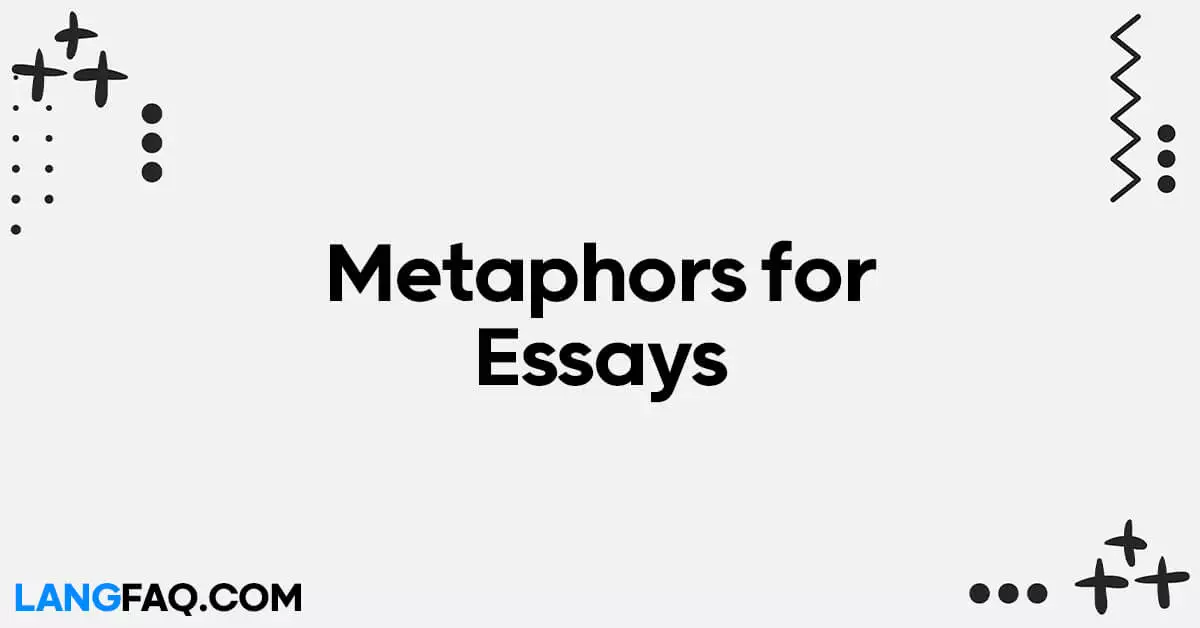
Share this post:
Welcome to the realm of literary expression, where words transcend their literal meanings. In the intricate dance of language , metaphors emerge as poetic devices, breathing life into essays. This guide delves deep into the art of crafting essays with 26 metaphors, unraveling the tapestry of creativity and linguistic elegance.
26 Metaphors for Essays
- The Essay as a Journey : Navigating through the pages is like embarking on a literary expedition, each paragraph a step forward in exploration.
- Words as Building Blocks: Just as a builder meticulously selects bricks, the writer chooses words to construct the foundation of their essay.
- Essays as Time Capsules of Thought: Imagine essays as sealed capsules, preserving and encapsulating the essence of thoughts for future revelation.
- The Pen as a Sword: In the hands of a skilled writer, the pen transforms into a mighty sword, carving narratives that leave a lasting impact.
- The Canvas of Ideas: Essays are blank canvases awaiting the strokes of creativity, each idea a vibrant color adding depth to the masterpiece.
- The Musical Composition of Sentences: Sentences harmonize like musical notes, with metaphors as the chords that create a symphony of literary brilliance.
- Metaphors as Sparks of Imagination: Like sparks that ignite a fire, metaphors fuel the flames of imagination, turning the mundane into the extraordinary.
- Weaving Metaphors in the Fabric of Expression: Writers, akin to skilled weavers, interlace metaphors into the very fabric of their expression, creating textured narratives.
- The Alchemy of Creativity in Writing: Metaphors, like alchemists’ potions, possess the transformative power to turn ordinary words into literary gold.
- Essays as Gardens of Ideas: Cultivating ideas in essays is akin to tending a garden, with each thought blooming like a unique, vibrant flower.
- The Essayist as an Architect: Just as an architect plans a structure, essayists carefully design their compositions, selecting metaphors as architectural embellishments.
- Metaphors as Bridges: In the vast landscape of ideas, metaphors act as bridges, connecting the reader to the writer’s thoughts seamlessly.
- The Essayist as a Sculptor: Sculpting words, essayists chisel away the unnecessary, revealing the masterpiece within, with metaphors adding intricate details.
- The Essay as a Puzzle: Each paragraph in an essay is a puzzle piece, and metaphors are the connectors that bring coherence to the overall picture.
- Metaphors as Light in Darkness: Just as a beam of light dispels darkness, metaphors illuminate essays, revealing hidden nuances and depths.
- Essays as Culinary Delights: Crafting an essay is like preparing a culinary masterpiece, with metaphors as the seasonings that enhance the flavor.
- The Essay as a Conversation: Essays engage in a dialogue with readers, and metaphors serve as eloquent conversationalists, making the exchange more dynamic.
- Metaphors as Windows: They open windows to new perspectives, allowing readers to view familiar concepts in refreshing and insightful ways.
- The Essay as a Symphony: Like a symphony, essays require harmony, and metaphors contribute the musicality that resonates with the reader.
- Essays as Mirrors: Reflecting thoughts and ideas, essays are mirrors that reveal the depth of the writer’s insights, with metaphors as the silver lining.
- The Essayist as a Gardener of Ideas: Just as a gardener tends to plants, essayists nurture ideas, with metaphors acting as the fertilizer that promotes growth.
- Metaphors as Spice in Writing: Essays become literary dishes, and metaphors are the spices that infuse the writing with zest and vibrancy.
- Essays as Constellations: Like stars in a constellation, each idea in an essay forms a unique pattern, with metaphors connecting them into a meaningful whole.
- The Essayist as a Tour Guide: In the journey of an essay, the writer is a guide, and metaphors are the landmarks that make the experience memorable.
- Metaphors as Puzzle Pieces: Each metaphor fits into the essay like a puzzle piece, contributing to the overall coherence and completeness.
- The Essay as a Tapestry: Woven with threads of ideas, an essay is a tapestry, and metaphors add intricate patterns that make it visually and intellectually appealing.
These metaphors provide imaginative ways to conceptualize the art of essay writing.
Words as Building Blocks
In the intricate process of crafting an essay, words serve as the foundational building blocks, carefully selected to construct a robust structure that conveys the intended message. This metaphor emphasizes the importance of precision and thoughtfulness in word choice.
When to Use:
- Formal Context: In academic or professional essays where clarity and precision are paramount.
- Informal Context: When sharing personal reflections or experiences in a blog post.
Example: Formal Context: “In scholarly endeavors, each word acts as a building block, contributing to the solid foundation of academic discourse.”
Informal Context: “As I penned down my thoughts, I realized how each word became a building block, shaping the narrative of my personal journey.”
Variations:
- Colleague Interaction: “In our collaborative report, let’s ensure every word functions as a building block for a cohesive document.”
- Friend’s Feedback: “Your storytelling is fantastic! Each word feels like a building block, constructing a vivid picture in my mind .”
Pros and Cons:
- Pros: Enhances clarity, strengthens the essay’s structure.
- Cons: Risk of overthinking word choice; may slow down the writing process.
Grammar/Usage Rule: Ensure that each word used aligns with the overall tone and purpose of the essay, maintaining consistency and coherence.
Definition: The metaphor “words as building blocks” underscores the foundational role of individual words in constructing a well-organized and impactful essay.
- Consider the connotation and nuance of each word.
- Use a diverse vocabulary to add richness to the essay.
Essays as Time Capsules of Thought
As we delve into the realm of essay writing, envisioning essays as time capsules offers a poignant perspective. Each essay becomes a vessel, encapsulating and preserving the essence of thoughts, ideas, and perspectives for future revelations.
- Formal Context: Reflecting on the historical significance or evolution of ideas.
- Informal Context: Sharing personal reflections on life experiences.
Example: Formal Context: “In academic writing, essays act as time capsules, capturing the intellectual evolution of concepts over the years.”
Informal Context: “As I penned my reflections on the past year, I realized my journal entries serve as time capsules, preserving my thoughts and emotions.”
- Mentor-Mentee Discussion: “Your thesis is a time capsule, showcasing the evolution of your research journey.”
- Friend’s Feedback: “Your travel essay reads like a time capsule, vividly preserving the essence of your adventures.”
- Pros: Adds depth and significance to the essay; offers a reflective element.
- Cons: May require a thoughtful selection of ideas for preservation.
Grammar/Usage Rule: Ensure the ideas encapsulated in the essay align with the overall theme and purpose, maintaining coherence.
Definition: The metaphor “essays as time capsules” highlights the role of essays in preserving and encapsulating thoughts and ideas for future reference.
- Clearly define the time frame or context within which the ideas are encapsulated.
- Use vivid language to enhance the time-capsule imagery.
The Pen as a Sword
In the arsenal of writing metaphors, the imagery of the pen as a sword captures the transformative power wielded by skilled writers. Every stroke becomes a strategic move, carving narratives with precision and leaving a lasting impact on readers.
- Formal Context: Emphasizing the persuasive and influential nature of academic or professional writing.
- Informal Context: Crafting compelling narratives in personal essays or storytelling.
Example: Formal Context: “In legal discourse, the pen is indeed a sword, capable of shaping and reshaping the boundaries of jurisprudence.”
Informal Context: “As I penned my travel memoir, I felt the pen transform into a sword, carving tales of adventure and exploration.”
- Colleague Collaboration: “Let’s approach this proposal as if the pen is a sword, crafting a persuasive argument.”
- Friend’s Response: “Your creative writing is a sword, cutting through ordinary narratives with a unique edge.”
- Pros: Emphasizes the impact of words; encourages powerful and persuasive writing.
- Cons: Requires a nuanced approach to avoid excessive or inappropriate use.
Grammar/Usage Rule: Ensure that the metaphor aligns with the tone and objective of the writing, maintaining professionalism and impact.
Definition: The metaphor “the pen as a sword” symbolizes the influential and transformative power of words, likening them to a weapon in the hands of a skilled writer.
- Use this metaphor judiciously to highlight key points or arguments.
- Consider the ethical implications of wielding the “pen-sword.”
The Canvas of Ideas
In the realm of essay writing, viewing essays as blank canvases awaiting strokes of creativity emphasizes the unlimited potential for expression. Each idea is a vibrant color, contributing to the masterpiece being painted with words.
- Formal Context: Encouraging creativity in academic writing, particularly in subjects where innovative ideas are valued.
- Informal Context: Expressing personal thoughts, feelings, or reflections with a creative flair.
Example: Formal Context: “In scientific research, essays serve as canvases, allowing researchers to paint groundbreaking ideas that challenge existing paradigms.”
Informal Context: “My personal essay on resilience became a canvas of ideas, each paragraph a stroke depicting my journey through challenges.”
- Mentor-Mentee Discussion: “Approach your thesis as a canvas, where each idea contributes to the overall masterpiece.”
- Friend’s Feedback: “Your essay on friendship is a vibrant canvas, portraying the beauty of companionship.”
- Pros: Fosters creativity; encourages a fresh and innovative approach to writing.
- Cons: Requires a balance to prevent excessive embellishment that might dilute the message.
Grammar/Usage Rule: Ensure that the metaphor aligns with the overall purpose of the essay, maintaining coherence and relevance.
Definition: The metaphor “the canvas of ideas” illustrates the creative and expressive nature of essays, likening them to a blank canvas waiting to be adorned.
- Encourage experimentation with ideas, allowing for a diverse and colorful essay.
- Use vivid language to enhance the imagery of the canvas.
The Musical Composition of Sentences
In the symphony of essay writing, sentences harmonize like musical notes, and metaphors act as the chords that create a melodious and captivating composition. This metaphor highlights the rhythmic flow and cadence that metaphors contribute to the overall structure of an essay.
- Formal Context: Enhancing the eloquence of academic writing, particularly in literature or humanities disciplines.
- Informal Context: Infusing storytelling with a rhythmic and musical quality, making the narrative more engaging.
Example: Formal Context: “In literary analysis, consider each sentence as a musical note, and metaphors as the chords that elevate the entire composition.”
Informal Context: “As I crafted my personal essay, I aimed for a musical composition of sentences, where metaphors acted as harmonious chords guiding the reader through the narrative.”
- Colleague Collaboration: “Let’s approach the introduction like a musical composition, where each sentence sets the tone for the entire essay.”
- Friend’s Response: “Your storytelling reads like a musical composition, with metaphors serving as delightful harmonies.”
- Pros: Enhances the rhythm and flow of writing; adds a lyrical quality to the essay.
- Cons: Requires careful consideration to maintain coherence and prevent overuse.
Grammar/Usage Rule: Ensure that the musical metaphor aligns with the overall tone and theme of the essay, creating a harmonious blend.
Definition: The metaphor “the musical composition of sentences” evokes the rhythmic and harmonious quality of well-crafted sentences in essay writing.
- Pay attention to sentence structure and variety to create a musical rhythm.
- Experiment with pacing, using metaphors strategically to enhance the cadence.
Metaphors as Sparks of Imagination
Unlocking the door to creativity, metaphors serve as sparks that ignite the flames of imagination in the essay-writing process. This metaphor emphasizes the transformative power of metaphors in turning mundane concepts into vivid and imaginative expressions.
- Formal Context: Encouraging imaginative thinking in academic or technical writing, especially in fields where creativity is valued.
- Informal Context: Adding a touch of flair to personal narratives or creative non-fiction.
Example: Formal Context: “In scientific discourse, metaphors act as sparks, igniting new perspectives and fostering innovative approaches to complex problems.”
Informal Context: “As I delved into my reflective essay, I realized how metaphors served as sparks, transforming ordinary memories into vivid and imaginative stories.”
- Mentor-Mentee Discussion: “Think of metaphors as sparks in your thesis, infusing your research with imaginative and innovative thinking.”
- Friend’s Feedback: “Your metaphors are sparks of creativity, turning a simple story into a captivating adventure.”
- Pros: Stimulates creative thinking; adds a dynamic and engaging element to writing.
- Cons: Requires a balance to prevent excessive metaphorical embellishment.
Grammar/Usage Rule: Ensure that the metaphor aligns with the context and purpose of the essay, sparking imagination without veering off-topic.
Definition: The metaphor “metaphors as sparks of imagination” emphasizes the role of metaphors in sparking creative thinking and imaginative expression in essays.
- Experiment with unexpected metaphors to surprise and engage the reader.
- Use metaphors strategically to convey abstract concepts in a concrete and imaginative manner.
Weaving Metaphors in the Fabric of Expression
Imagine the act of essay writing as a textile art, where writers weave metaphors into the very fabric of their expression. This metaphor underscores the intricate and deliberate nature of incorporating metaphors seamlessly into the narrative.
- Formal Context: Emphasizing the artistry of language in academic or professional writing, particularly in literature or arts-related subjects.
- Informal Context: Conveying personal stories with a rich tapestry of metaphors, making the narrative more engaging.
Example: Formal Context: “In art history essays, consider metaphors as threads, intricately woven into the fabric of expression, adding depth and nuance to your analysis.”
Informal Context: “As I shared my life experiences in the essay, each metaphor became a thread, weaving through the fabric of expression and creating a vivid tapestry of my journey.”
- Colleague Collaboration: “Let’s approach the conclusion like skilled weavers, weaving metaphors into the fabric of expression for a memorable ending.”
- Friend’s Response: “Your metaphors are like threads, weaving through the fabric of your storytelling, creating a colorful and captivating narrative.”
- Pros: Enhances the richness of language; creates a visually appealing and immersive experience for the reader.
- Cons: Requires careful consideration to maintain coherence and prevent metaphorical overload.
Grammar/Usage Rule: Ensure that metaphors are seamlessly integrated into the overall narrative, contributing to the fabric of expression without overshadowing the main message.
Definition: The metaphor “weaving metaphors in the fabric of expression” portrays essay writing as a deliberate and artistic process where metaphors are integral to the overall composition.
- Use metaphors strategically to emphasize key points and evoke emotions.
- Ensure the metaphorical threads align with the thematic focus of the essay.
The Alchemy of Creativity in Writing
In the enchanting world of essay writing, metaphors act as alchemists’ potions, possessing the transformative power to turn ordinary words into literary gold. This metaphor emphasizes the magical and elevating quality that metaphors bring to the craft of writing.
- Formal Context: Encouraging creative thinking and expression in academic or professional essays, especially in disciplines that value originality.
- Informal Context: Elevating personal narratives or creative non-fiction with a touch of literary alchemy.
Example: Formal Context: “In philosophical discourse, metaphors act as alchemists, transmuting abstract concepts into literary gold, making complex ideas accessible and engaging.”
Informal Context: “As I explored my emotions in the essay, metaphors worked like alchemy, turning ordinary feelings into a golden tapestry of introspection.”
- Mentor-Mentee Discussion: “Think of metaphors as your writing alchemy, transforming ordinary ideas into literary treasures in your dissertation.”
- Friend’s Feedback: “Your metaphors are like alchemy, turning everyday stories into captivating narratives with a touch of magic.”
- Pros: Elevates writing to a higher level; adds a touch of magic and allure to the narrative.
- Cons: Requires careful selection to avoid overuse and maintain authenticity.
Grammar/Usage Rule: Ensure that metaphors align with the overall tone and purpose of the essay, contributing to the alchemy of creativity without becoming distracting.
Definition: The metaphor “the alchemy of creativity in writing” illustrates the transformative power of metaphors, turning ordinary words into literary gold in the process of essay crafting.
- Experiment with unconventional metaphors to infuse a sense of magic and wonder into the writing.
- Use metaphors sparingly to maintain their enchanting impact.
Essays as Gardens of Ideas
Embark with me on the metaphorical journey where essays are likened to gardens, and ideas flourish like vibrant flowers, adding color, depth, and fragrance to the narrative. This metaphor emphasizes the nurturing aspect of essay writing, where writers carefully cultivate and present a diverse array of ideas.
- Formal Context: Encouraging a comprehensive exploration of ideas in academic writing, especially in subjects that require depth and diversity of thought.
- Informal Context: Crafting personal essays that showcase a rich tapestry of thoughts and reflections.
Example: Formal Context: “In sociological essays, think of ideas as blossoming flowers, each representing a unique perspective contributing to the overall garden of knowledge.”
Informal Context: “My reflective essay on personal growth became a garden of ideas, where each paragraph bloomed like a distinct flower, revealing a different facet of my journey.”
- Colleague Collaboration: “Let’s approach this research paper like gardeners, nurturing diverse ideas that collectively enrich the overall narrative.”
- Friend’s Response: “Your essay is like a garden of ideas, with each thought blooming into a beautiful flower, creating a captivating bouquet of storytelling.”
- Pros: Encourages a holistic exploration of ideas; adds depth and diversity to the essay.
- Cons: Requires careful organization to ensure each idea contributes cohesively to the overall narrative.
Grammar/Usage Rule: Ensure that each idea is carefully cultivated and presented, contributing meaningfully to the overarching theme of the essay.
Definition: The metaphor “essays as gardens of ideas” conveys the nurturing and diverse nature of ideas in the essay-writing process, akin to tending to a garden.
- Cultivate a variety of ideas to create a rich and engaging narrative.
- Ensure a balance between depth and breadth in exploring different perspectives.
The Essayist as an Architect
Picture the essayist as an architect, meticulously planning the structure of an essay, with metaphors acting as architectural embellishments that enhance the overall design. This metaphor underscores the importance of thoughtful composition and strategic use of metaphors in crafting compelling essays.
- Formal Context: Emphasizing the strategic organization of ideas in academic or professional essays, especially in disciplines where structure is crucial.
- Informal Context: Applying a deliberate and structured approach to storytelling in personal essays.
Example: Formal Context: “In business essays, consider each section as a blueprint, and metaphors as architectural embellishments that reinforce the solidity of your argument.”
Informal Context: “As I constructed my narrative essay, I approached it like an architect, planning the structure with metaphors as decorative elements, enhancing the overall design.”
- Mentor-Mentee Discussion: “Approach your dissertation like an architect, with each chapter as a carefully planned structure, and metaphors as essential design elements.”
- Friend’s Feedback: “Your essay is like a well-designed building, with metaphors serving as architectural details that make the storytelling more compelling.”
- Pros: Enhances the organization and coherence of the essay; adds a visual and structural dimension to the writing.
- Cons: Requires careful planning to ensure metaphors align with the overall structure and theme.
Grammar/Usage Rule: Ensure that metaphors contribute to the architectural integrity of the essay, reinforcing the structure without overshadowing the core message.
Definition: The metaphor “the essayist as an architect” paints a vivid picture of the deliberate planning and structured approach to essay writing, with metaphors as integral architectural elements.
- Plan the essay structure carefully, assigning specific roles to different sections.
- Use metaphors strategically to reinforce key points and contribute to the overall coherence.
Metaphors as Bridges
Imagine the vast landscape of ideas in an essay as a series of islands, and metaphors as bridges that seamlessly connect these intellectual realms. This metaphor highlights the role of metaphors in creating smooth transitions between different concepts, ensuring a cohesive and engaging journey for the reader.
- Formal Context: Facilitating the logical progression of ideas in academic writing, especially in essays that explore diverse topics.
- Informal Context: Connecting personal anecdotes or reflections in a way that feels natural and effortless.
Example: Formal Context: “In political science essays, think of metaphors as bridges, linking theories and real-world applications to create a cohesive and insightful narrative.”
Informal Context: “As I shared my travel experiences, metaphors acted as bridges, seamlessly connecting one destination to another, creating a fluid and captivating storytelling experience.”
- Colleague Collaboration: “Let’s treat each section of our report as an island, and use metaphors as bridges to connect the ideas, ensuring a smooth transition between concepts.”
- Friend’s Response: “Your essay feels like a journey with metaphors serving as bridges, linking different aspects of your story in a way that flows naturally.”
- Pros: Enhances the flow of ideas; ensures a seamless transition between different sections.
- Cons: Requires thoughtful selection to maintain coherence and avoid abrupt shifts.
Grammar/Usage Rule: Ensure that metaphors serve as effective bridges, guiding the reader from one idea to the next without causing confusion or disconnection.
Definition: The metaphor “metaphors as bridges” emphasizes the role of metaphors in creating connections and maintaining a smooth flow of ideas in an essay.
- Use metaphors strategically at key transition points to guide the reader through the essay.
- Ensure that each metaphorical bridge enhances the overall coherence and narrative progression.
The Essayist as a Sculptor
Envision the essayist as a sculptor, shaping words and ideas with precision, and metaphors as intricate details that add depth and nuance to the crafted piece. This metaphor emphasizes the deliberate and artistic nature of essay writing, where every word contributes to the overall composition.
- Formal Context: Emphasizing the meticulous crafting of arguments and analysis in academic essays, particularly in disciplines that value precision.
- Informal Context: Adding an artistic flair to personal essays, where the narrative is shaped with care and intention.
Example: Formal Context: “In literary analysis, view metaphors as the sculptor’s chisel, carving out layers of meaning and interpretation with precision.”
Informal Context: “As I penned my reflective essay, I approached it like a sculptor, molding my experiences with metaphors as intricate details, shaping the narrative with care.”
- Mentor-Mentee Discussion: “Consider each paragraph as a piece of marble, and metaphors as the sculptor’s tools that refine and enhance the overall structure of your thesis.”
- Friend’s Feedback: “Your essay is like a sculpture, with metaphors as the detailed carvings that make the storytelling more vivid and impactful.”
- Pros: Elevates the writing to an artistic level; adds precision and depth to the overall composition.
- Cons: Requires careful consideration to avoid excessive ornamentation.
Grammar/Usage Rule: Ensure that metaphors act as sculptor’s tools, enhancing the clarity and impact of the essay without overshadowing the main message.
Definition: The metaphor “the essayist as a sculptor” conveys the intentional and artistic approach to essay writing, where metaphors serve as tools for refinement and precision.
- Approach each paragraph with the intention of sculpting a clear and impactful narrative.
- Use metaphors sparingly to maintain the overall focus and coherence of the essay.
The Essay as a Symphony
Envision the essay as a symphony, where each paragraph contributes a unique note, and metaphors act as harmonious chords that resonate throughout the composition. This metaphor underscores the rhythmic and coordinated nature of a well-structured essay, where metaphors play a vital role in creating a harmonious narrative.
- Formal Context: Emphasizing the orchestration of ideas in academic essays, particularly in subjects that require a cohesive and interconnected argument.
- Informal Context: Crafting personal essays with a rhythmic flow, where each metaphor contributes to the overall harmony of the narrative.
Example: Formal Context: “In historical essays, metaphors function as chords, weaving through each paragraph and creating a symphony of interconnected ideas that resonate with the reader.”
Informal Context: “As I shared my life story in the essay, I aimed for a symphony of emotions, where metaphors acted as chords, adding depth and resonance to my narrative.”
- Colleague Collaboration: “Let’s approach the conclusion as the grand finale of our symphony, using metaphors as chords to create a lasting impression on our readers.”
- Friend’s Response: “Your essay reads like a symphony, with metaphors serving as harmonious chords that make the storytelling captivating and memorable.”
- Pros: Enhances the overall rhythm and coherence of the essay; creates a memorable and engaging reading experience.
- Cons: Requires careful selection to maintain thematic unity and prevent discordant notes.
Grammar/Usage Rule: Ensure that metaphors contribute to the symphonic nature of the essay, creating a cohesive and well-orchestrated composition.
Definition: The metaphor “the essay as a symphony” conveys the coordinated and rhythmic nature of a well-structured essay, where metaphors function as harmonious chords.
- Use metaphors strategically to emphasize key themes and create a sense of unity.
- Consider the pacing and placement of metaphors to enhance the overall symphonic experience.

The Essayist as a Navigator
Picture the essayist as a navigator, steering through the vast sea of ideas with precision, and metaphors as navigational tools that guide readers through the intellectual journey. This metaphor emphasizes the strategic use of metaphors to ensure clarity and coherence in the exploration of complex topics.
- Formal Context: Emphasizing the logical progression and navigation of ideas in academic essays, especially in disciplines that require a clear and structured argument.
- Informal Context: Creating personal essays where metaphors act as guiding lights, making the narrative accessible and engaging.
Example: Formal Context: “In scientific essays, metaphors function as navigational tools, guiding readers through the intricate concepts and ensuring a clear understanding of the research.”
Informal Context: “As I delved into philosophical reflections, I saw myself as a navigator, using metaphors as guiding stars to lead readers through the complexities of my thoughts.”
- Mentor-Mentee Discussion: “Treat your literature review as a navigational map, and use metaphors as tools to guide your readers through the diverse scholarly perspectives.”
- Friend’s Feedback: “Your essay is like a journey with you as the navigator, and metaphors as compass points that make the exploration both insightful and enjoyable.”
- Pros: Enhances the clarity and accessibility of complex ideas; guides readers through a well-structured intellectual journey.
- Cons: Requires thoughtful selection to avoid confusion and maintain the logical flow.
Grammar/Usage Rule: Ensure that metaphors function as effective navigational tools, aiding readers in understanding the progression of ideas in the essay.
Definition: The metaphor “the essayist as a navigator” portrays the intentional and strategic role of metaphors in guiding readers through the intellectual landscape of an essay.
- Use metaphors to introduce and connect key concepts in a way that aids understanding.
- Ensure that each metaphor aligns with the overall theme and purpose of the essay.
The Essay as a Kaleidoscope
Imagine the essay as a kaleidoscope, where ideas and perspectives shift and blend, creating a vibrant and ever-changing pattern. Metaphors, in this context, serve as the colorful elements that contribute to the kaleidoscopic richness of the narrative.
- Formal Context: Emphasizing the diversity of perspectives and ideas in academic writing, particularly in subjects that encourage varied viewpoints.
- Informal Context: Crafting personal essays with a dynamic and ever-evolving exploration of experiences and reflections.
Example: Formal Context: “In cultural studies essays, metaphors function as elements in a kaleidoscope, allowing readers to see the same topic from different angles, creating a nuanced and comprehensive understanding.”
Informal Context: “As I shared my personal journey, I envisioned my essay as a kaleidoscope, with each metaphor adding a burst of color, shaping the ever-shifting pattern of my experiences.”
- Colleague Collaboration: “Let’s approach this interdisciplinary essay as a kaleidoscope, where each section contributes a unique perspective, and metaphors act as the vibrant elements that tie everything together.”
- Friend’s Response: “Your storytelling is like a kaleidoscope, with metaphors adding diverse hues to the narrative, creating a rich and captivating tapestry.”
- Pros: Adds richness and diversity to the narrative; encourages readers to appreciate multiple facets of a topic.
- Cons: Requires careful organization to prevent the essay from becoming disjointed.
Grammar/Usage Rule: Ensure that metaphors contribute to the kaleidoscopic nature of the essay, enhancing the overall vibrancy and diversity of perspectives.
Definition: The metaphor “the essay as a kaleidoscope” portrays the dynamic and ever-changing nature of ideas and perspectives, with metaphors as key elements that contribute to the kaleidoscopic richness.
- Use metaphors strategically to explore different aspects of a topic.
- Ensure a cohesive and well-structured essay, even as perspectives shift and evolve.
The Essayist as a Gardener of Thought
Visualize the essayist as a gardener, tending to the seeds of thoughts and ideas with care, and metaphors as the nutrients that enrich the intellectual soil. This metaphor emphasizes the nurturing aspect of essay writing, where metaphors play a vital role in cultivating a fertile ground for insightful discussions.
- Formal Context: Encouraging the development and growth of ideas in academic writing, particularly in essays that require in-depth exploration.
- Informal Context: Crafting personal essays with a focus on the careful cultivation of thoughts and reflections.
Example: Formal Context: “In psychological essays, metaphors serve as nutrients for the intellectual garden, fostering the growth of theories and facilitating a deeper understanding of complex concepts.”
Informal Context: “As I explored my personal beliefs, I saw myself as a gardener of thoughts, using metaphors as nutrients to cultivate a rich and flourishing landscape of ideas.”
- Mentor-Mentee Discussion: “Approach your thesis as a garden of thoughts, and let metaphors act as the nutrients that enhance the intellectual richness of your research.”
- Friend’s Feedback: “Your essay feels like a carefully tended garden, with metaphors serving as nutrients that make the ideas flourish and bloom.”
- Pros: Fosters the growth and development of ideas; contributes to a nuanced and well-explored narrative.
- Cons: Requires thoughtful selection to ensure metaphors align with the overall theme and purpose.
Grammar/Usage Rule: Ensure that metaphors act as effective nutrients, enhancing the intellectual soil and contributing to the overall richness of the essay.
Definition: The metaphor “the essayist as a gardener of thought” conveys the intentional and nurturing approach to essay writing, where metaphors play a vital role in fostering the growth of insightful ideas.
- Use metaphors strategically to enrich the intellectual landscape of the essay.
- Ensure a balanced and well-nurtured exploration of ideas, even as metaphors contribute to their growth.
How do metaphors enhance essays?
Metaphors elevate essays by adding depth and vividness, making abstract concepts relatable and engaging.
- Use metaphors when you want to evoke emotions and create a lasting impression.
- Employ metaphors in descriptive and narrative writing to paint vivid pictures for your readers.
Example: “Incorporating metaphors in your essay enhances the overall reading experience, transforming abstract concepts into tangible images that resonate with your audience.”
Tip: “Experiment with various metaphors to find the ones that best convey your intended message. Consider the emotions and images each metaphor evokes.”
Can I use metaphors in academic essays?
Absolutely! Thoughtful use of metaphors can enhance the clarity and impact of academic writing.
- Introduce metaphors sparingly in academic essays to emphasize key points.
- Ensure that the metaphor aligns with the formal tone of academic writing and enhances understanding.
Example: “While maintaining academic rigor, strategic use of metaphors can elucidate complex theories and captivate the reader’s attention in your research paper.”
Tip: “Avoid clichéd metaphors in academic writing. Instead, opt for metaphors that bring fresh perspectives to your subject matter.”
Are clichéd metaphors a red flag?
While clichés should be used sparingly, a well-placed familiar metaphor can effectively convey ideas.
How to choose the right metaphor?
Consider your message and audience; choose metaphors that resonate and enhance your intended meaning.
Can metaphors be humorous in essays?
Certainly! Humorous metaphors inject personality into your writing, making it more enjoyable for readers.
Do metaphors work in technical writing?
Yes, when used judiciously. Metaphors can simplify complex ideas, aiding understanding in technical writing.
In conclusion, the arsenal of metaphors is a potent tool for crafting essays that linger in the minds of readers. This guide has unveiled the artistry of metaphorical expression, encouraging writers to embrace creativity and wield metaphors with finesse. As you embark on your essay-writing journey, remember the transformative power of metaphors in shaping literary masterpieces.
Similar Posts
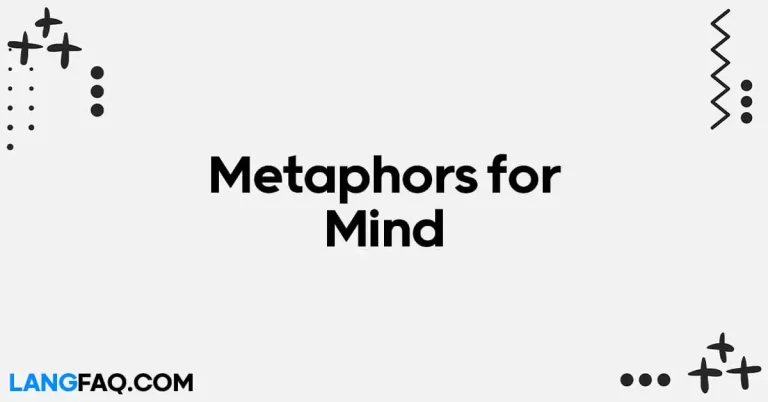
26 Metaphors for Mind: Unveiling the Intricacies
Share this post: Facebook X Pinterest The mind, a labyrinth of thoughts and emotions, often defies straightforward description. In this exploration, we’ll embark on a journey through 26…
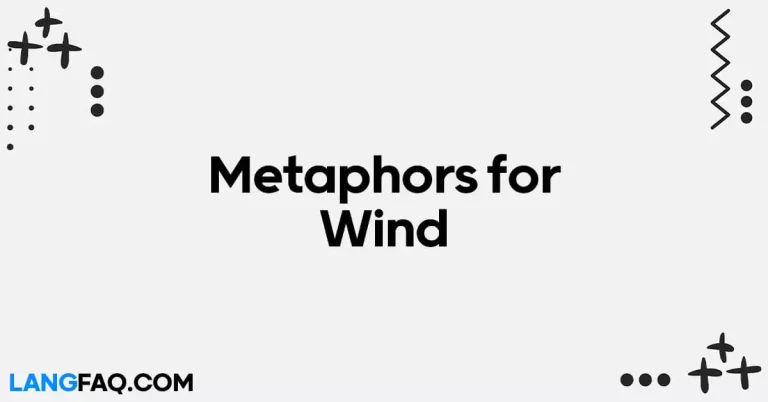
26 Metaphors for Wind: Unveiling Elemental Poetry and Inspirational Dance of Transformation
Wind, a force of nature that dances through the air, whispers stories to those who listen. In this comprehensive exploration, we unravel the poetic tapestry of wind through…

26 Metaphors for Smile: Unlocking the Beauty of Happiness
Smiles are universal expressions of joy, happiness, and warmth. They have the power to brighten up our day and create connections between people. In this article, we’ll delve…
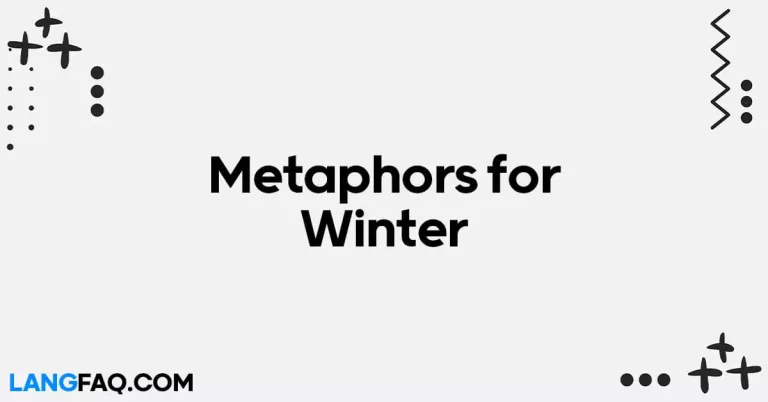
26 Metaphors for Winter: Embracing the Beauty of the Season
Winter, with its frosty charm and serene landscapes, has inspired poets, writers, and artists for centuries. It’s a season of transformation, where the world is blanketed in a…
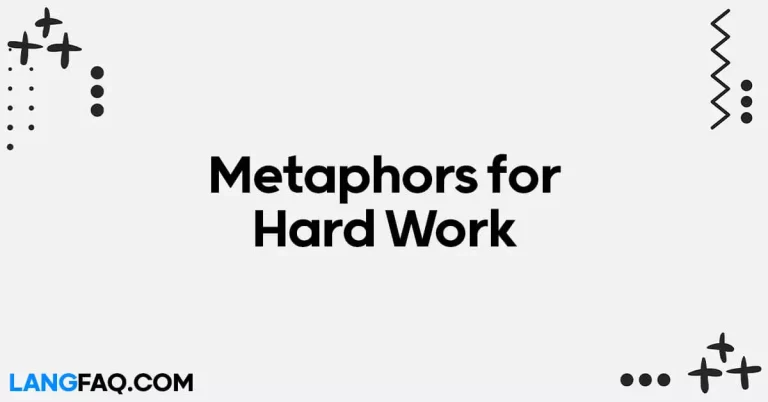
26 Metaphors for Hard Work: Unveiling the Power of Persistence
In the pursuit of success, hard work is the driving force that propels us forward. It’s the unrelenting dedication, the tireless effort, and the unwavering commitment that lead…
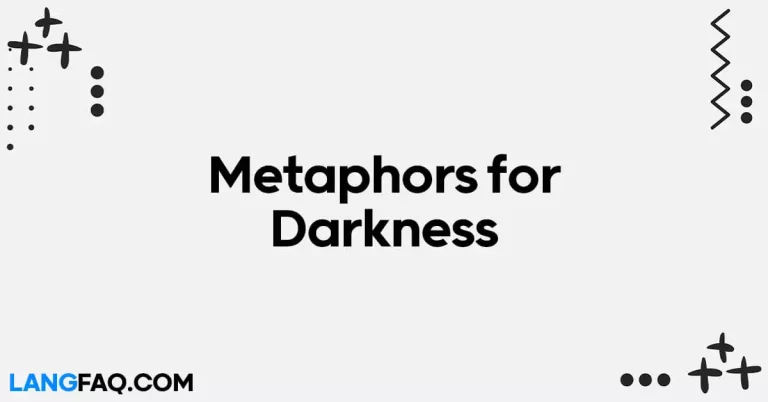
Exploring 26 Metaphors for Darkness: A Comprehensive Guide
In the realm of literature, darkness is more than the mere absence of light. It’s a canvas onto which writers paint vivid emotions, sensations, and ideas. In this…

IMAGES
VIDEO
COMMENTS
26 Metaphors for Essays. The Essay as a Journey: Navigating through the pages is like embarking on a literary expedition, each paragraph a step forward in exploration. Words as Building Blocks: Just as a builder meticulously selects bricks, the writer chooses words to construct the foundation of their essay.